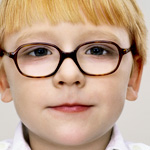Seeing Clearly: When Your Child Needs Glasses
Published on
Health Tip of the WeekPublished on
Health Tip of the Week It starts slowly — your child begins to squint at the television or complains that he has to move closer to the front of the class to see the blackboard. Your child is becoming myopic, or nearsighted. He can see objects very well up close, but far away they are a big old blurry mess.
It starts slowly — your child begins to squint at the television or complains that he has to move closer to the front of the class to see the blackboard. Your child is becoming myopic, or nearsighted. He can see objects very well up close, but far away they are a big old blurry mess.
Myopia is very common, and is most often diagnosed as your child enters adolescence and experiences a growth spurt. If you or your spouse (or both) are myopic, chances are your child will be as well. You child will need glasses or contact lenses to correct his vision. Other common eye conditions that require glasses or contact lenses include hyperopia (farsightedness), where far away objects are clear and close objects are blurry; and astigmatism, where both far and close objects are blurry.
Some kids might not tell you that they are having trouble seeing; they may be embarrassed or not understand that there is a problem. Here are some signs your child needs corrective lenses:
If your child needs corrective lenses, you can make an appointment with an ophthalmologist or an optometrist. Your child will receive a vision test to determine the strength of the lenses needed. Your child may be self-conscious about wearing glasses, so be patient and understanding.
Contributed by: Patrick S. Pasquariello, MD
Categories: Weekly Health Tips, Eyes
Are you looking for advice to keep your child healthy and happy? Do you have questions about common childhood illnesses and injuries? Subscribe to our Health Tips newsletter to receive health and wellness tips from the pediatric experts at Children's Hospital of Philadelphia, straight to your inbox. Read some recent tips.